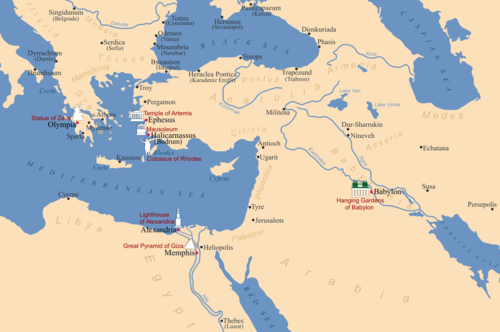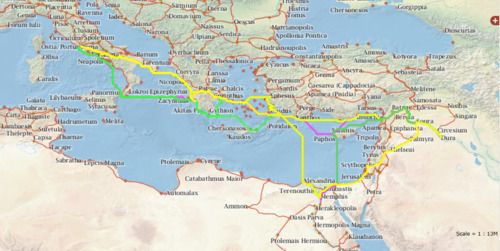In ancient Rome, today, May 9th, marked the first day of the Lemuria, a three day religious holiday during which lemurs were exorcized from private homes by throwing beans, banging on pots and pans, and making obscene hand gestures.
The thing about the Lemuria that most interests me is the throwing beans part, and I'll come back to that, but first some clarification about the Lemuria. If you have been picturing cute, little, furry, big-eyed lemurs, erase that image from your mind. Lemurs in ancient Rome were spirits of the dead. (For you students of Latin that should be lemures, lemurum.) The precise nature of lemurs is unclear, although most define them as "malevolent" spirits. The Romans in fact had a number of words that can generally be translated as "spirit of the dead" or "ghost." Among these are larva, umbra, manes, spectrum, simulacrum, and borrowed Greek words like phantasma and idolon.
Our best source of information on the Lemuria is the Augustan era poet Publius Ovidius Naso (ca. 43 B.C.-17 A.D.), better known to English speakers as Ovid. In his Fasti, a poem about Roman holidays, Ovid tells us that the Lemuria was celebrated on May 9th, 11th and 13th. These days were marked with an "N" on the Roman calendar, indicating that they were unfavorable, or nefas, days for conducting official activities. In fact, Ovid says (Fasti 5.485-489) that the doors of the temples were closed, meaning that the Roman Senate could not meet and conduct official business, and that one should not marry in May as the bride would not live for long. According to Ovid the Lemuria was a very ancient festival, dating back to the founding of Rome. He provides an origin myth for the festival with a spurious etymological argument. The festival began with the funeral rites of Remus, who was killed by his brother Romulus. Remus' bloodied ghost appeared to his adoptive parents asking them to intercede with Romulus to establish a day of celebration in honor of Remus. Romulus agrees and the Remuria is established. Presumably, Ovid is identifying the Remuria as the Lemuria, not only because of their ghostly connections, but also due to a common pattern of linguistic change (a.k.a. dissimulation) in which "R" becomes "L" (e.g. Latin "peregrin" becomes "pilgrim" in English). Whatever its origin, Ovid says the Lemuria is an ancient festival and it was apparently still being observed at the start of the seventh century A.D. when Pope Boniface (608-615 A.D.) established May 13th as All Saints' Day and consecrated the Pantheon to Mary and the Saints. Boniface hoped to divert the common people of Rome from celebration of the Lemuria to a Christan substitute.
More importantly, in this passage of the Fasti (5.431-444), Ovid gives us the ritual by which a Roman householder rid his home of lemurs:
nox ubi iam media est somnoque silentia praebet,
et canis et variae conticuistis aves,
ille memor veteris ritus timidusque deorum
surgit (habent gemini vincula nulla pedes),
signaque dat digitis medio cum pollice iunctis,
occurrat tacito ne levis umbra sibi.
cumque manus puras fontana perluit unda,
vertitur et nigras accipit ante fabas,
aversusque iacit; sed dum iacit, 'haec ego mitto,
his' inquit 'redimo meque meosque fabis.'
hoc novies dicit nec respicit: umbra putatur
colligere et nullo terga vidente sequi.
rursus aquam tangit, Temesaeaque concrepat aera,
et rogat ut tectis exeat umbra suis.
cum dixit novies 'manes exite paterni'
respicit, et pure sacra peracta putat.
(Excerpted from The Latin Library)
"When it's the middle of the night and silence offers sleep, and the dogs and the spotted birds have fallen silent, that man mindful of the ancient rites and fearful of the gods rises (his two feet are unshod), and he makes the sign with his fingers joined in the middle to his thumb, lest an unsubstantial ghost run into him in the silence. And when he has washed his hands clean in spring water, he turns and first of all takes some black beans, and, turning back, he throws them; but while he throws them "These I cast to you," he says, "with these beans I avert evil from both myself and my family." He says this nine times and does not look back: the ghost is thought to collect the beans and to follow behind the man who does not see the ghost. Again he touches the water, and he bangs the bronze pots from southern Italy, and he asks that the ghost leave his home. When he has said "Spirits of my fathers, go!" nine times he looks back, and he reckons that the sacred rites have been carried out completely." (My translation)
And that is how you can purge your house of lemurs at midnight on Sunday, May 13th.
There are a couple of things worth noting in the various parts of the ritual. The hand gesture being described is probably what is known in modern Italian as the "mano cornuto" (the horned hand) and is known in contemporary American culture from heavy metal concerts and University of Texas football games. The index finger and little finger are raised, while the thumb holds the two middle fingers down on the palm. The "mano cornuto" has its origin in ancient Italy, where it is seen in Etruscan tombs, and it serves as an apotropaic gesture used to ward of evil. The fact that the household repeats the sacred words nine times undoubtedly was meant to make the words as powerful as possible. Nine is composed of three sets of three, and three is a magical number, think of the Roman preference for divine triads, or the Christian Father, Son and Holy Ghost. Finally, the bronze pots from southern Italy, or as the Latin reads literally "bronze from Temesa," are ritually significant because bronze was the preferred metal for sacrificial implements. Temesa, located in Calabria, was apparently well-known for the quality of its copper mines.
The thing I have always found intriguing about this passage is the ritual of throwing beans over one's shoulder to appease the lemurs and make them leave. Now beans are significant in the ancient world for a variety of reasons (e.g. in Pythagorean beliefs, in other rituals associated with dead) that I won't go into here, because I am more interested in the method of throwing, rather than what is being thrown.
This ritual carried out at the close of the Lemuria belongs to a series of other rituals that involve throwing objects over one's shoulder both to protect oneself and to bring good fortune, which are of course two aspects of the same idea. And I suspect that, through comparisons with other throwing rituals, its possible to assert that the householder threw the beans with his right hand over his left shoulder.
Some comparanda:
Salt. Throwing salt is a common ritual performed after one spills some salt. The origin of this ritual are uncertain, but it probably arose in part due to the costliness of salt in historical periods. The most common throwing method is to take a pinch of the spilt salt with one's right hand and toss it over one's left shoulder. It is said that the devil sits on one's left shoulder and that throwing salt over that shoulder blinds the devil, or distracts him, and prevents one from being cursed for wastefulness.
A couple of interesting observations about salt. Everyone knows, of course, that the human body is composed of a large quantity of salt and that salt is necessary for life. Conversely, salt is used, and has been used for centuries, to preserve meats.
The Trevi Fountain. Anyone who has been to Rome, knows that one needs to throw a coin in the Trevi Fountain to ensure a future return trip. As the ritual procedure was explained to me, one turns one's back on the fountain and casts the coin over his left shoulder with his right hand. I have also been told, and this seems to be a common belief based on a quick internet search, that one can throw a second and third coin into the fountain to ensure marriage and/or divorce.
Weddings. Throwing the bridal bouquet and bride's garter are common wedding rituals. The tossing of the bouquet appears to have developed as a defense mechanism for the bride. At least as early as the Middle Ages the bride's wedding garments were considered to bestow good luck and after the wedding the guests would try to rip portions of the cloth. It seems that the practice of throwing a bouquet developed by the Renaissance to allow the transfer of bridal luck without the bride losing her clothes! The groom's throwing of the bride's garter also allows that transfer of good luck. The good luck associated with bridal bouquets and garters is of course a very specific sort of luck: those who catch the bouquet and garter are destined to be the next to marry. Presumably, it is possible to extend this good luck to cover not only marriage, but also the birth of children.
Deucalion & Pyrrha. The myth of Deucalion and Pyrrha is coincidentally best preserved for us in another of Ovid's poems, Metamorphoses (1.313-415). This aged and childless couple is often compared to Noah and his wife. Because of their piety, Deucalion and Pyrrha are forewarned by Zeus of the coming flood that is designed to eradicate the largely impious human population. As Ovid relates the story, the couple ride out the flood in a tiny boat and eventually make landfall on the slopes of Mt. Parnassus. As they observe the flood-washed world around them, they are struck by its emptiness. Seeking guidance, they appeal to the goddess Themis, whose shrine is conveniently located there on Parnassus. Themis tells them to "leave the shrine! Cover your heads and loosen the fastenings on your garments and throw the bones of your great mother behind your back!" Pyrrha is troubled by this oracle as she fears desecrating her mother's grave, but Deucalion arrives at the correct interpretation. He realizes that the "great mother" is mother earth and that her bones are stones. When they cast the rocks over their shoulders as ordered, each rock is transformed into a human being as it hits the earth. The stones cast by Pyrrha become women, those by Deucalion become men.
The Lemuria and these other rituals are performed to ensure prosperity and bring good fortune to a household. In the cases of throwing spilt salt and coins into the Trevi Fountain the prescribed ritual requires one to throw over one's left shoulder with one's right hand and I'd argue that this was the same procedure used for the Lemuria.





